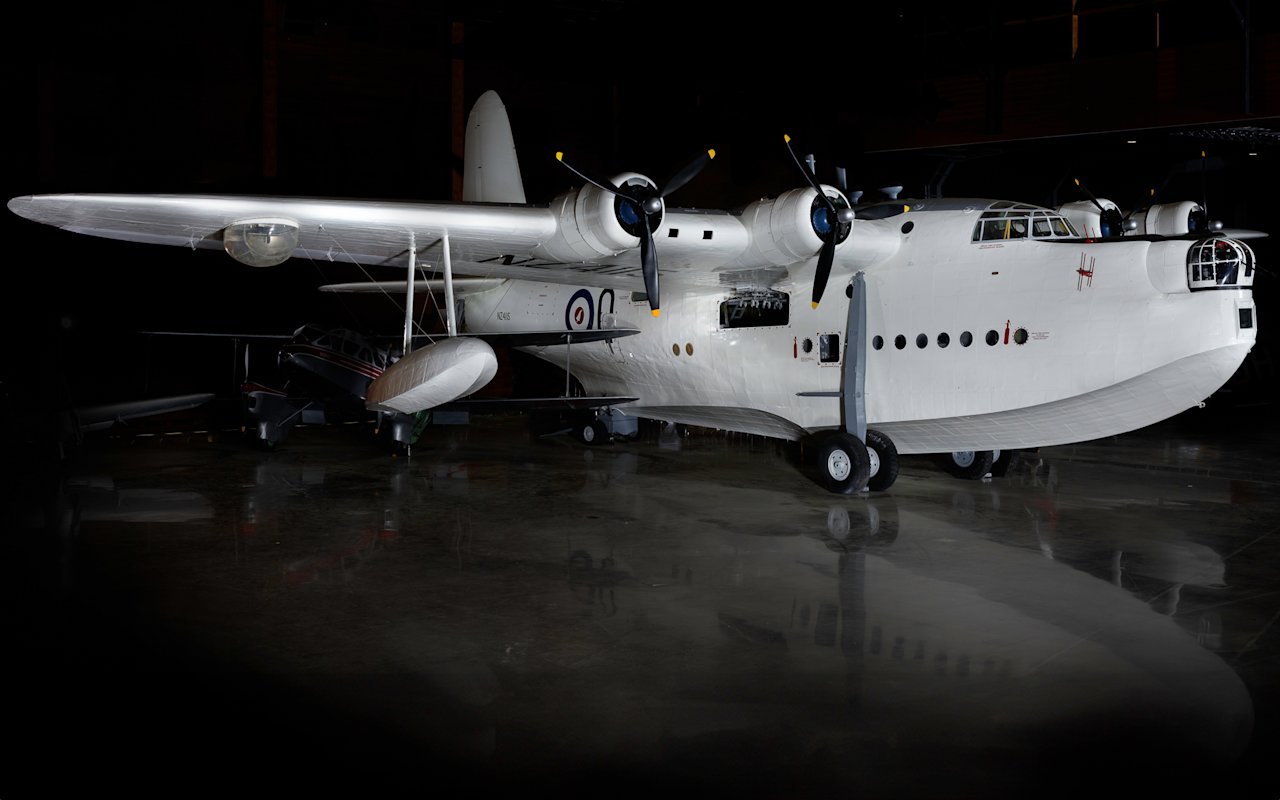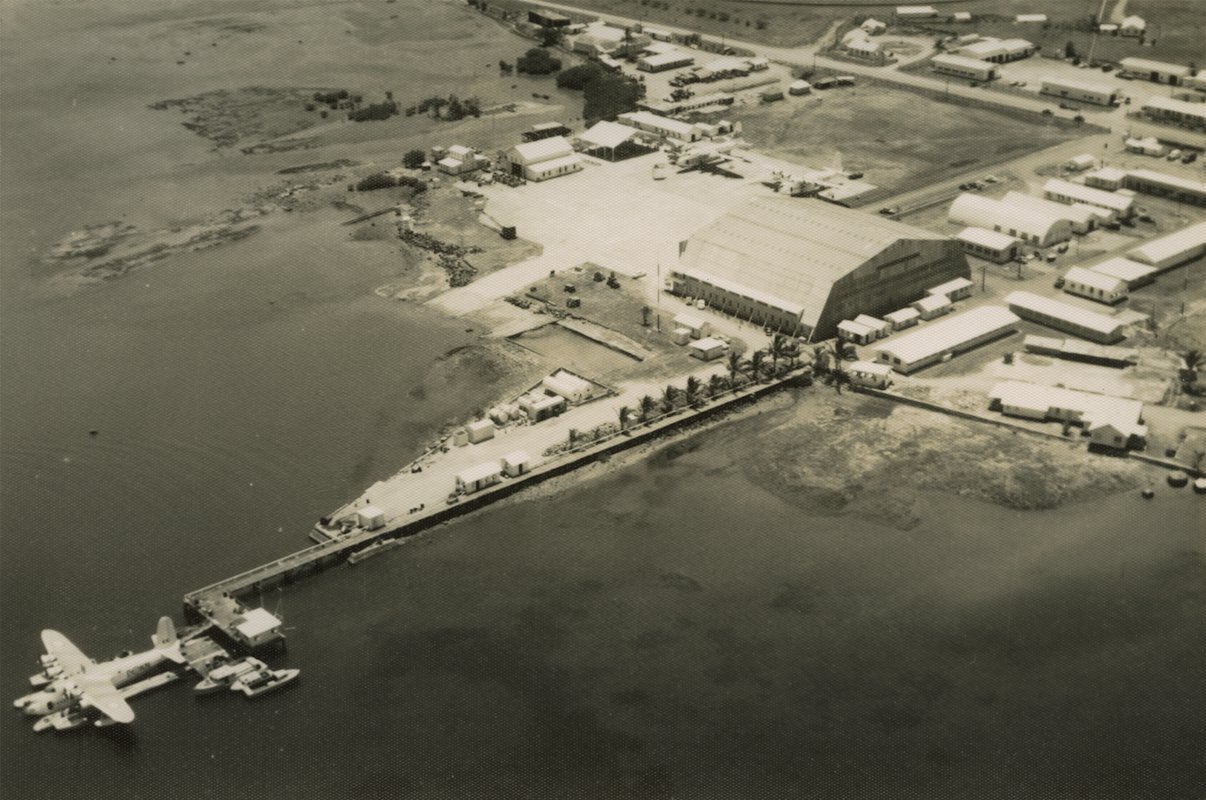MOTAT’s Short Sunderland – a rare, reconnaissance flying boat

A history of MOTAT's Short S.25 Sunderland

The Short S.25 Sunderland on display in MOTAT's Aviation Hall.
Designed for long-range flight
The Short S.25 Sunderland flying boat was designed in the early 1930s to United Kingdom Air Ministry specification R.2/33 for a four-engine monoplane to serve in coastal patrol and long-range reconnaissance roles. The specification requested a flying boat that could fly a range of 1400 sea miles at 2000 feet normal cruising speed with a full reconnaissance load, had the ability to fly with only two engines on while carrying a full military load (40% of full load), and a ceiling of 15,000 feet among other requirements.
The design was based upon the successful "C" Class "Empire" flying boats in conjunction with the contract for the Short Brothers S.23 Empire flying boat for Imperial Airways. Compared to the S.23 it featured a more advanced aerodynamic hull and was outfitted with various offensive and defensive armaments, including machine gun turrets, bombs, aerial mines and depth charges. It also had detection equipment to aid combat operations, including the Leigh arc light, which was an anti-submarine device, radar and an astrodome. The array of machine guns earned the aircraft the nickname of "Porcupine" (Stachelschwein) from German pilots during the Second World War.
The Sunderland was used by Royal Air Force (RAF) Coastal Command during that war as an integral part of Search and Rescue (SAR) missions, maritime patrol and anti-submarine warfare, and the RAF continued to use the Sunderland in a military capacity up to 1959. Around a dozen aircraft participated in the Berlin airlift from mid-1948 to mid-1949, delivering supplies to the blockaded German city, and between mid-1950 and September 1954, several squadrons of RAF Sunderlands saw combat action during the Korean War. The aircraft were also used by the French Fleet Air Arm, the South African Air Force and the Royal New Zealand Air Force (RNZAF).

RNZAF Short Sunderland moored at Lauthala Bay, Fiji, WAC_2010_018_011_001, Walsh Memorial Library, Museum of Transport and Technology.
Built in Belfast
A number of Sunderland Mark III aircraft were converted for use within the civil sector, where they were known as the Short Sandringham. TEAL (Tasman Empire Airways Ltd) used the Sandringham known as ZK-AME ‘New Zealand’ on the trans-Tasman route between Auckland and Sydney from September 1946 until the Short Solent flying boats arrived in 1947.
The Sunderland Mark V, of which the aircraft known at MOTAT as NZ4115 is an example, was developed in 1944 from the Mark III by replacing the latter's Bristol Pegasus engines with more powerful Pratt and Whitney Wasp 14-cylinder radial air-cooled engines. Both user and maker had already identified the need for more powerful engines, so, both Shorts and No. 10 Squadron RAAF were respectively allocated ML839 and ML765 Sunderlands to experiment with and convert into what would finally be produced as a Mark V.
NZ4115 was built by Short Brothers, Belfast in 1945 for the Royal Air Force (RAF) as SZ584. It was then held in reserve by the RAF, probably at 57 MU (Maintenance Unit) at RAF Wig Bay seaplane base in Scotland. From May 1946 to April 1948 it was loaned to the BOAC airline (British Overseas Airline Corporation) for crew training and was flown as G-AHJR.

Print of Short Sunderland V in flight, PHO-2019-1.1. Walsh Memorial Library, The Museum of Transport and Technology (MOTAT).
Connecting the Pacific
SZ584 was then reconditioned and delivered with 15 other Mark V Sunderlands to the RNZAF in 1953. The RNZAF had selected Sunderlands to replace their ageing Catalina flying boats, which had now been in service for 10 years. Sunderlands were used by 5 and 6 Squadrons, based at Laucala Bay in Fiji and at Hobsonville air base in Auckland, and by the Maritime Operational Conversion Unit. The Laucala Bay Sunderland squadron was there to meet New Zealand’s obligations under the ANZAM agreement. This was a Commonwealth defence plan – the name was derived from the countries it encompassed: Australia, New Zealand and British-ruled Malaya – and its initial concern was the protection of wartime sea communications in the area. However, they came to represent more than coastal defence and played important role in connecting Pacific communities by delivering medical supplies, passengers and vital freight to islands that could not yet accommodate fixed-wing land aircraft. Footage in the MOTAT Collection shows a flyover of Sunderlands on the decommissioning of the Laucala Bay Base, with locals seen waiving on the aircraft flying in unison.
By the early 1960s the RNZAF began to think of replacing the flying boats with modern land-based aircraft. In 1962, the establishment of six Sunderlands with 5 Squadron in Laucala Bay was reduced to four. In 1966, 5 Squadron returned to Whenuapai and was equipped with Lockheed Orions, but a detachment of two Sunderlands was left in Laucala Bay to cover routine commitments. In 1967 these two were finally withdrawn from Laucala Bay and the base closed. On 2 April that year, the last RNZAF Sunderland, NZ4107 flew back to Hobsonville – the last official sortie of these old flying boats.

RNZAF Short Sunderland over Rangitoto, 12-3019, Walsh Memorial Library, Museum of Transport and Technology.
Arrival at MOTAT
NZ4115 operated with No 5 Squadron as KN-A, KN-B and then as KN-Q (Queenie) and then at Hobsonville airbase with the Maritime Reconnaissance Support Unit. In 1966 it was gifted to MOTAT, officially handed over in September that year, and presented in December 1966 by the Minister of Defence. It arrived at MOTAT in February 1967, having been towed down the Waitemata Harbour and dragged over Meola Road, Point Chevalier to its resting place outside at what is now MOTAT Motions Road.
Restoration work
In the years following NZ4115's arrival to MOTAT, the Motions Road site developed into the main storage and display area for visitors to view the museum's aircraft collection. During the early 1980s, a blister hangar was moved onsite; a move which opened up a sizable and weather-proof workshop area for small and mid-size aircraft restoration to take place, as well as providing a place for the Aviation section volunteers to meet. At the same time, plans were being made to build a display hall, and in the early 1980s, the Keith Park Memorial (KPM) hall was opened. Throughout this time, the Sunderland remained outside, where it was able to be viewed by visitors and worked on by the volunteers. Since arriving in 1967, there has been a mix of restoration, maintenance and conservation work undertaken on NZ4115, including the reattachment of the wing tips and floats, the addition of gun turrets, the reinstatement of the engines and exterior repainting.
In 2007 MOTAT’s Motions Road site was redeveloped with the blister hangar being moved to the back to the site to accommodate an extension onto the KPM hall (this hall would become known as the Aviation Display Hall (2011-2021), and later the Aviation Hall (2021 onwards). This large extension was opened in 2011, but it would be several more years before the Sunderland was displayed inside. In preparation for this, the aircraft needed extensive exterior maintenance and a repaint. This work was completed in 2017, and the Sunderland was finally moved inside the Aviation Hall, where it has been a popular collection piece for visitors, and has recently become part of the Te Koitu immersive digital experience.
Short Sunderland
Date: 1946
Manufacturer: Short Brothers & Harland Ltd, Belfast, Northern Ireland
Type: Four-engine long-range reconnaissance & anti-submarine flying boat
Wing span: 34.39 m
Length: 26 m
Engine: Four 1200 HP Pratt & Whitney R-1830-90B Twin Wasp 14-cylinder engines
Armament: Six .303 inch Browning machine guns in Fraser-Nash turrets, two in the nose, and four in the tail. A .50 calibre Browning heavy machine gun could also be mounted in open hatch beam positions, and four .303 inch Browning machine guns in the sides of the nose.
Useful sources:
Mac Bettjeman, Sunderland on Patrol, Auckland, Mac Bettjeman, 2004 [?] – about Bettjeman’s experiences as a Short Sunderland pilot during the Second World War
Chaz Bowyer. 1989. The Short Sunderland, 91-007. Walsh Memorial Library, The Museum of Transport and Technology (MOTAT).
Ian Brausch, interviewed by Megan Hutching, 2 August 2012, Walsh Memorial Library, MOTAT, accession number 12-3927 – covers his service in RNZAF 5 Squadron based at Laucala Bay, Fiji
David Eyre, The Illustrated Encyclopedia of Aircraft in Australia and New Zealand, Auckland, Pacific Publishers, 1988
http://www.airforce.mil.nz/about-us/news/airforce-news/archive/132/the-short-sunderland.htm
Article written by: Megan Hutching & Belinda Nevin.
Edited by: Chelsea Renshaw.
Published: January 2024.